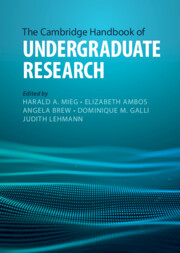Book contents
- The Cambridge Handbook of Undergraduate Research
- The Cambridge Handbook of Undergraduate Research
- Copyright page
- Contents
- Figures
- Tables
- Contributors
- Foreword
- Foreword
- 1 Introduction
- Part I Theory and Research on Undergraduate Research
- Part II Implementation, Approaches, Methods
- Part III Disciplines
- Part IV International Perspective
- 47 Introduction
- Part IV.1 Americas
- Part IV.2 Africa & Middle East
- Part IV.3 Asia & Oceania
- Part IV.4 Europe
- 64 Undergraduate Research in Austria
- 65 Undergraduate Research in France
- 66 Undergraduate Research in Germany
- 67 Undergraduate Research in Italy
- 68 Undergraduate Research in the Netherlands
- 69 Undergraduate Research in Portugal
- 70 Undergraduate Research in Russia
- 71 Undergraduate Research in Scandinavia
- 72 Undergraduate Research in the UK
- Part V Avenues for Developing Undergraduate Research
- Index
- References
67 - Undergraduate Research in Italy
A Formative Approach to Foster Engagement with Community and Business
from Part IV.4 - Europe
Published online by Cambridge University Press: 11 August 2022
- The Cambridge Handbook of Undergraduate Research
- The Cambridge Handbook of Undergraduate Research
- Copyright page
- Contents
- Figures
- Tables
- Contributors
- Foreword
- Foreword
- 1 Introduction
- Part I Theory and Research on Undergraduate Research
- Part II Implementation, Approaches, Methods
- Part III Disciplines
- Part IV International Perspective
- 47 Introduction
- Part IV.1 Americas
- Part IV.2 Africa & Middle East
- Part IV.3 Asia & Oceania
- Part IV.4 Europe
- 64 Undergraduate Research in Austria
- 65 Undergraduate Research in France
- 66 Undergraduate Research in Germany
- 67 Undergraduate Research in Italy
- 68 Undergraduate Research in the Netherlands
- 69 Undergraduate Research in Portugal
- 70 Undergraduate Research in Russia
- 71 Undergraduate Research in Scandinavia
- 72 Undergraduate Research in the UK
- Part V Avenues for Developing Undergraduate Research
- Index
- References
Summary
The Italian university system comprises 97 institutions (67 state universities, 19 legally recognized private universities, and 11 online universities). Italian universities display divergent characteristics by mission, structure, size, and location. There are different vocations (generalist vs. specialist, research-oriented vs. teaching-oriented), which involve different structures and performances that are difficult to compare. In the last decade, practices and experiences related to the engagement through partnership model have matured, focusing on the participation of students as partners in the development of research, both campus-based but especially community- and work-based. An overview of the national literature on these experiences highlights how they fall within the framework of collaborative action-research and the promotion of dialogue between universities and society, which has been particularly encouraged since 2009 by numerous European documents aimed at encouraging “a new partnership for the modernization of universities” and collaboration between universities and organizations.
Keywords
- Type
- Chapter
- Information
- The Cambridge Handbook of Undergraduate Research , pp. 607 - 615Publisher: Cambridge University PressPrint publication year: 2022



